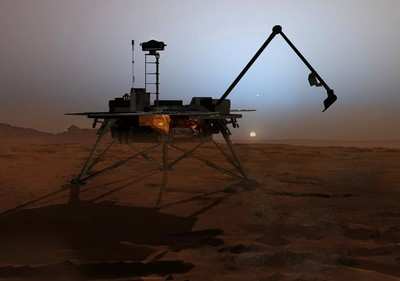Wed, Jul 16, 2008
Team Hopes To Analyze Sample Of Icy Soil
A powered rasp on the back of the robotic arm scoop of NASA's
Phoenix Mars Lander is being tested for the first time on Mars in
gathering sample shavings of ice.

Phoenix team members at NASA's Jet Propulsion Laboratory report
the lander has used its arm in recent days to clear away loose soil
from a subsurface layer of hard-frozen material and create a large
enough area to use the motorized rasp in a trench informally named
"Snow White."
The Phoenix team prepared commands early Tuesday for beginning a
series of tests with the rasp later in the day. Engineers and
scientists designed the tests to lead up to, in coming days,
delivering a sample of icy soil into one of the lander's laboratory
ovens.
"While Phoenix was in development, we added the rasp to the
robotic arm design specifically to grind into very hard surface
ice," said Barry Goldstein, Phoenix project manager at JPL in
Pasadena, CA. "This is the exactly the situation we find we are
facing on Mars, so we believe we have the right tool for the job.
Honeybee Robotics in New York City did a heroic job of designing
and delivering the rasp on a very short schedule."
 The rasp bit extends at a shallow angle out of an opening on
the back of the scoop at the end of the 2.35-meter-long
(7.7-foot-long) robotic arm. To use it, the back surface of the
scoop is placed on the ground, and a motor rotates the rasp. The
angle of the rasp is increased from nearly horizontal to slightly
steeper while it is rotating, so the tool kicks shavings sideways
onto a collection surface just inside the opening. After the rasp
stops, a series of moves by the scoop then shifts the collected
shavings from the back of the scoop, past baffles, to the front of
the scoop. The baffles serve to keep material from falling out of
the rasp opening when the scoop is used as a front loader.
The rasp bit extends at a shallow angle out of an opening on
the back of the scoop at the end of the 2.35-meter-long
(7.7-foot-long) robotic arm. To use it, the back surface of the
scoop is placed on the ground, and a motor rotates the rasp. The
angle of the rasp is increased from nearly horizontal to slightly
steeper while it is rotating, so the tool kicks shavings sideways
onto a collection surface just inside the opening. After the rasp
stops, a series of moves by the scoop then shifts the collected
shavings from the back of the scoop, past baffles, to the front of
the scoop. The baffles serve to keep material from falling out of
the rasp opening when the scoop is used as a front loader.
The commands prepared for Phoenix's activities Tuesday called
for rasping into the hard material at the bottom of the Snow White
trench at two points about one centimeter (0.4 inch) apart. The
lander's Surface Stereo Imager and robotic arm camera will be used
to check the process at several steps and to monitor any resulting
sample in the scoop for several hours after it is collected.
Collecting an icy sample for an oven of Phoenix's Thermal and
Evolved-Gas Analyzer (TEGA) may involve gathering shavings
collected at the rasp opening and scooping up additional shavings
produced by the rasp. The Phoenix team has been testing this
combination on simulated Martian ice with a near-replica model of
Phoenix in a test facility at the University of Arizona,
Tucson.
More News
He Attempted To Restart The Engine Three Times. On The Third Restart Attempt, He Noticed That Flames Were Coming Out From The Right Wing Near The Fuel Cap Analysis: The pilot repor>[...]
Make Sure You NEVER Miss A New Story From Aero-News Network Do you ever feel like you never see posts from a certain person or page on Facebook or Instagram? Here’s how you c>[...]
From 2009 (YouTube Edition): Leading Air Show Performers Give Their Best Advice for Newcomers On December 6th through December 9th, the Paris Las Vegas Hotel hosted over 1,500 air >[...]
Aero Linx: NASA ASRS ASRS captures confidential reports, analyzes the resulting aviation safety data, and disseminates vital information to the aviation community. The ASRS is an i>[...]
“For our inaugural Pylon Racing Seminar in Roswell, we were thrilled to certify 60 pilots across our six closed-course pylon race classes. Not only did this year’s PRS >[...]
 NTSB Final Report: Rutan Long-EZ
NTSB Final Report: Rutan Long-EZ ANN FAQ: Turn On Post Notifications
ANN FAQ: Turn On Post Notifications Classic Aero-TV: ICAS Perspectives - Advice for New Air Show Performers
Classic Aero-TV: ICAS Perspectives - Advice for New Air Show Performers ANN's Daily Aero-Linx (06.28.25)
ANN's Daily Aero-Linx (06.28.25) Aero-News: Quote of the Day (06.28.25)
Aero-News: Quote of the Day (06.28.25)




